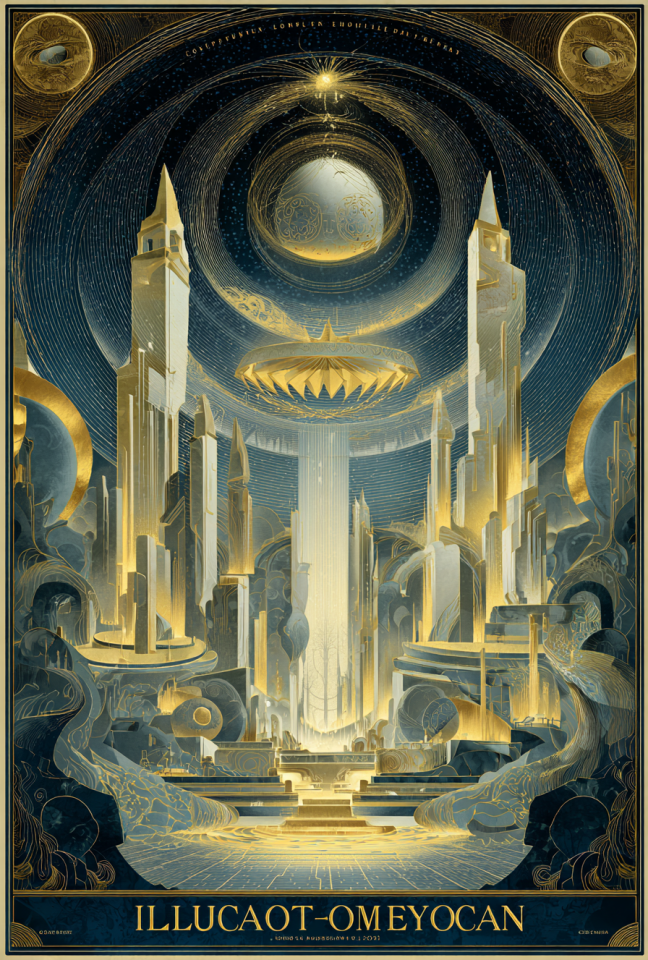Ilhuicatl-Omeyocan is the sacred summit of the Mexica cosmos — a Divine Realm beyond polarity, where male and female, light and dark, silence and sound, exist in perfect unity. It is the thirteenth and highest heaven the realm from which all existence flows, yet which itself remains untouched by conflict or decay. Governed by Ōmeteōtl — the divine duality comprising Ometecuhtli and Omecihuatl — this realm is the womb and still point of creation where every soul, force, and god once began their motion. Ilhuicatl-Omeyocan is not a place of reward or residence — it is the axis of sacred duality, still veiled to mortals, though its pulse is present in all life.
Landscape and Essence
Ilhuicatl-Omeyocan is a realm of profound symmetry and luminous quiet. It is described not in form, but in feeling — like being inside a thought before it takes shape. The space shimmers with silver and gold light, not from stars, but from the union of forces that never separate. Structures appear and dissolve — jade temples that bloom and fade like breath, rivers of motion that flow without direction. Every element exists in pairs, yet they do not oppose; they reflect, echo, and renew each other. Sound here is soft, harmonic, almost untraceable — like the first heartbeat of the cosmos. It is not cold or warm, bright or dark — it is whole.
Inhabitants
Ilhuicatl-Omeyocan is the domain of Ōmeteōtl the dual-essence deity composed of Ometecuhtli ("Lord of Duality") and Omecihuatl ("Lady of Duality"). This being does not walk, speak, or rule — it radiates. Unlike the active gods of war, rain, or sun, Ōmeteōtl is pure generative potential simultaneously male and female, light and shadow, silence and form. There are no other permanentInhabitants
— no ancestors, no spirits. Even the other gods do not dwell here; they were once born from here, shaped by its resonance, then descended to their own realms. Only Ōmeteōtl remains, eternal and unmoved, the god who is rather than does.
Cultural Significance
For the Mexica, Ilhuicatl-Omeyocan was not widely invoked in daily ritual — it was too elevated, too abstract, too sacred. But it underpinned all cosmology: every god, every calendar cycle, every force in the world could be traced back to the dual energy of Ōmeteōtl and the still perfection of this realm. Priests and philosophers understood Ilhuicatl-Omeyocan as the source of all the place where even the sun and stars were imagined into being. Though ordinary people rarely named it, its influence was everywhere — in maize and water, in fire and night, in the roles of man and woman, always braided into ritual life. As colonization shattered indigenous religious systems, the concept of dual divinity was silenced — yet in Nahua thought, poetry, and blood memory, Ilhuicatl-Omeyocan endures.
Role in the Divine Realm
Ilhuicatl-Omeyocan is the cosmic origin point — the place where the design of creation was formed, not by command, but by balance. It is not a paradise or a destination; it is the eternal stillness that allows motion to exist. The realm does not govern; it sustains. All other Divine Realms ripple outward from it — even those that oppose or destroy. Ilhuicatl-Omeyocan offers no judgment, no forgiveness, no voice — only the infinite presence of becoming. It is the source code of the divine cosmos.
Interactions with Other Realms
In the earliest days of creation, all other gods emerged from Ilhuicatl-Omeyocan, carrying aspects of its balance. Since then, the realm has remained untouched, even by the divine. No spirit, no soul, no god may reenter without complete dissolution of individuality. Shamans and priests of the highest rank once attempted communion through ritual fasting, bloodletting, and ecstatic trance, seeking a glimpse — not of the realm itself, but of the harmony it embodied. But now, even these rituals have faded, and the Veil is absolute. Ilhuicatl-Omeyocan can no longer be approached — it can only be remembered, through acts of balance, beauty, and sacred duality.
















